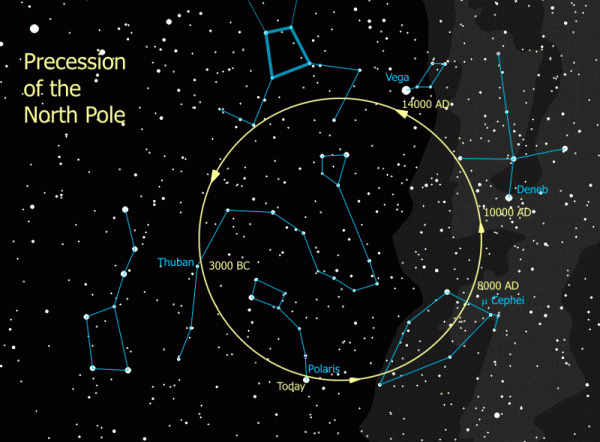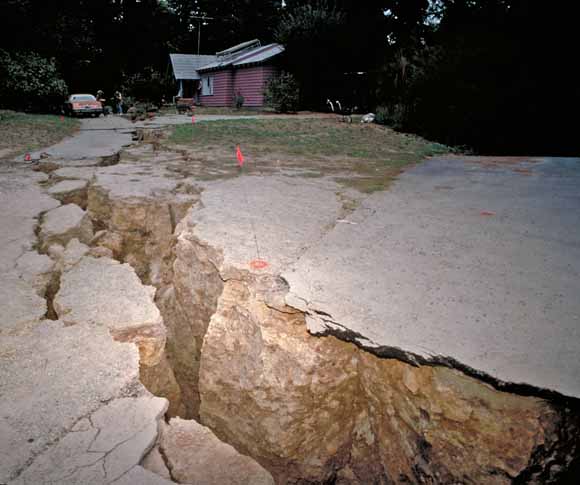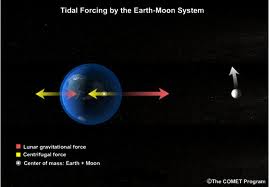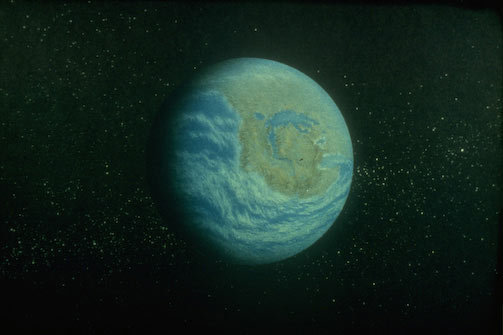"When in doubt, make a fool of yourself. There is a microscopically thin line between being brilliantly creative and acting like the most gigantic idiot on earth. So what the hell, leap." -Cynthia Heimel
Once every four years, the elusive entity that is today -- February 29th -- comes along. The historical origins and urban legends associated with it are incredibly interesting, but the reason there's any such thing as Leap Day at all is because of the physics of planet Earth.
The Earth, of course, is rotating on its axis while simultaneously revolving around the Sun. Rotation, as we all learn, is responsible for sunrise, sunset, moonrise, moonset, the Coriolis effect, and the rotation of all the stars in the night sky about the poles. Revolution, on the other hand, is responsible for the seasons; when your hemisphere tilted away from the Sun, that's when you have your winter (and minimum daylight), and when your hemisphere is tilted towards the Sun, that's when you have your luminous summer.
And you probably learned that a day is 24 hours, due to the rotation, while a year is 365 days (with an occasional 366 for leap years), taking care of the revolution. It turns out it's a little more complicated than that, so let's dive in!
The Earth completes a full rotation in less than 24 hours: 23 hours, 56 minutes and 4.09 seconds, to be more precise. But even though we've spun around a full 360 degrees, we've progressed just a little bit in our orbit around the Sun. If we insisted on using the 23:56:04.09 figure as our day, the Sun would be out at midnight for half the year! To fix the motion of the Earth around the Sun, we need those extra 3 minutes and 56 seconds to orient ourselves correctly. That takes care of what a day is, but what about a year? A revolution -- for the Earth to return to the same position with respect to the Sun -- might be an interesting astronomical thing to mark, it isn't a useful definition for a year on Earth.
In order for the Earth to achieve the same seasonal position in its orbit around the Sun -- and trust me, if you live on Earth, you'll want to mark your calendars by the seasons -- you'll need for the Earth to be oriented the exact same way with respect to the Sun as it was exactly one revolution ago. We could do this from winter solstice to winter solstice, when the Earth's north pole (for me) points maximally away from the Sun, or any other arbitrary point in its orbit. This way of measuring the year, known as the tropical year, is actually a little shorter than the astronomical measurement of a year we might be tempted to make.
Because the Earth only needs to revolve slightly less than 360 degrees around the Sun to make one tropical year. The difference is tiny -- 359.986 degrees instead of 360 -- but enough to make the tropical year about 20 minutes shorter than the sidereal (or astronomical) year. This difference is known as precession, and it explains why the pole star in the night sky appears to change very slowly over a period of about 26,000 years. (25,771 years, for the sticklers.)
Combine all three of those effects together -- rotation, revolution, and precession -- and you can answer the question of how many days will it take the Earth to make a tropical year?
The answer, as precisely as we can figure for 2012, is 365.242188931 days. If we just had 365 days in the year every year, we'd be off by nearly a month every century, which is pretty lousy. Putting in a leap year (with an extra day) every 4th year gets us closer, giving us 365.25 days in a year. (This was how we kept time with the Julian Calendar, which we followed for 1,600 years!) Still, this difference was significant enough that, by 1582, we had put in 10 too many days. For this reason, October 5th through October 14th of 1582 never existed in Italy, Poland, Spain and Portugal, with other countries skipping 10 days at a later date. The Gregorian calendar, which we now follow, is exactly the same as the Julian calendar, except instead of having a leap year if your year is divisible by 4 (as 2012 is), you don't get a leap year on the turn-of-the-century unless your year is also divisible by 400! So even though 2,000 was a leap year, 1,900 wasn't and 2,100 won't be, but 2,400 will be again. When did your country make the switch?

The adoption of the Gregorian calendar gives us a calendar of with -- over time -- 365.2425 days in the year. In comparison with the present, actual figure of 365.242188931 days, it will take over 3,200 years for us to be off by a single day, which is certainly good enough for a little while.
But if we want to be planning for the long term, we shouldn't simply be thinking about this difference. We should be thinking about the fact that the Earth's rotation rate is changing, and over long enough amounts of time, so should our definition of what a "day" is!
What am I talking about? Two things happen that change the Earth's rotation rate, and they push the day in opposite directions.
Every time we have an earthquake, that's mass inside the Earth rearranging itself so that -- by the conservation of angular momentum -- its rotation speeds up a little bit. For instance, last year's Japanese earthquake shortened the day by 1.8 microseconds, and the 9.1 Sumatra earthquake in 2004 shortened the day by 6.8 microseconds. On the other hand, there are two bodies out there with large gravitational effects on the Earth!
The Sun and the Moon both exert gravitational pulls on the Earth, all while the Earth itself rotates. If the Earth were just a point in space, this wouldn't matter; the Earth would make its elliptical orbit around the Sun, the Earth-Moon system would orbit their center of mass, and nothing would change. But because the Earth is a sphere, both the Sun and the Moon exert greater gravitational pulls on the side of Earth that's closer to them than on the side that's farther away.
Throw in the Earth's rotation, and you not only get tides, you also get tidal braking, which causes the Earth's rotation to slow down!
The slow-down is small but pretty consistent, at an average of 14 microseconds per year, a much larger effect than the speedup due to earthquakes. And over geological times, this really adds up! If we go back to the daily patterns left in the soil from the tides -- known as tidal rhythmites -- we can calculate what the period of Earth's rotation was from it.
If we look at the most ancient one we know of on Earth, from 620 million years ago, we find that a day back then was a little under 22 hours long!
If you extrapolate this tidal braking back to when the Earth was first formed, 4.5 billion years ago, you'll find that a day was originally only around 23,000 seconds, or six-and-a-half hours!
And the best part about this is that the Earth continues to slow down! Every 18 months or so, because of the difference between 86,400 seconds and an actual day, we add an extra leap second to our clocks (for now). Wait around for around four million years or so, and the day will lengthen by about 56 seconds, enough that we won't even want leap year anymore; a year will have exactly 365 Earth days!
So appreciate this leap day and our attention to detail to getting the Earth's seasons to remain constant from year-to-year, but also be aware that our Earth, however imperceptibly, means that these leap days, too, shall pass.











Has the slowdown been consistent over Earth's history?
In geological history there have been times when the land-bearing tectonic plates all bunched together, forming a super-continent surrounded by a super-ocean.
This super-ocean allowed much more freedom for tidal effects on the Earth's ocean. By contrast, when the continents are scattered over the Earth, as they are now, there is only one region where a tidal wave can travel all the way round: the Antarctic Sea.
It is my understanding that it has been theorized that during ages of super-continents tidal effects were stronger; hence friction from tidal effects was stronger, and a comparatively large proportion of the slowdown took place during these ages.
other countries skipping 10 days at a later date
Or more, as the Wikipedia page explains. For instance, Great Britain and possessions (including what later became the United States) adopted the Gregorian calendar in September 1752, which was only 19 days long. I have heard (not sure if it's true, as birth certificates weren't issued in those days) that George Washington was actually born on 11 February, but adjusted it to 22 February when Great Britain switched to the Gregorian calendar. Isaac Asimov noted in an essay on this topic that when his family emigrated from the USSR to the US, he lost 13 days as a result of switching from the Julian calendar (still in use in the USSR at the time; the "October Revolution" actually occurred during Gregorian November) to the Gregorian calendar.
@myself
On the other hand: a quote from the site 'Ask an astronomer':
http://curious.astro.cornell.edu/question.php?number=700
"And as it happens, it takes about 12 hours for a big wave to slosh across the Pacific Ocean and back--just in time for its height to be reinforced by the next high tide. So because of the size of the Pacific Basin, the Moon is very effective at slowing the Earth's rotation right now."
Well, err.. I fold my case.
It's plausible that the rate of slowdown has varied over geological time, but it's not know by how much.
Cleon,
For what it's worth, I have heard others argue that, back at the Solar System's inception, Earth's rotational period may have been as long as eight hours, due to variations in the frictional torque that our planet has been susceptible to over our history.
I think the 6.5 hour estimate is close enough to even those very conservative estimates that I'd consider an argument to be splitting hairs at this point. But it is fun to think about!
Some places (like Ethiopia) still use the Julian calendar. It's currently 2003. Come step back into time (in more way than one)!
Now try the physics of the leap second..!
Mind you, if anyone can tell me why the business world hate the leap day and explain THAT, that would be of far greater interest.
How come the angular forces of earthquakes only occur in the direction of Earth's rotation? I would have expected the direction to be random and for earthquakes to cancel each other out.
@6 Philipp:
Let me guess, because earthquakes represent a conversion of gravitational potential energy into heat energy; driven ultimately by the earth cooling and shrinking. I suppose mountain-building must be driven by subsidence somewhere, how else? So the speedup doesn't come from a "push" by the earthquake, which has nothing to push against, but by conservation of angular momentum as the effective radius of the earth shrinks.
May also be for the same reason why low pressure weather systems all rotate the same way round: the Coriolis force. Therefore there isn't a random act, it's a driven one, and driven in only one direction.
3/4/12
From Pico to macro earth time change has been the order of the day, is now, and will be. What has been ignored in this discussion is back in time new arrivals adding to the mass of the earth and altering the earth's revolution and rotation cycle as the earth continues its spinning through space and time.
Once there was a 30th February.
It has only happened once in one country
Funny fantasy, since the planets don't orbit the sun. The planets follow the sun in a vortex as the sun moves through the galaxy. Even Stellarium gets it right and shows the planets visible to each other nearly all year long.
Would like to know to details all information
43.
It's a leap day, so add one.
"The planets follow the sun in a vortex as the sun moves through the galaxy"
1) That's not a vortex
2) That still means they orbit the sun.